How To Cook Red Mill Cream Of Wheat
I've alluded to this post/series for a while now but I'one thousand more excited than should be accounted rational to finally be bringing you the first installment of the official Wheat and Wheat Grinding 101 series. Perhaps I'g the simply one that gets giddy when talking about wheat (Huh? Weird? Me?) but alas, I exercise and I promise some of this data will be benign to those of you interested in wheat and wheat grinding.
I make no try to hide my deep and abiding love for my wheat grinder and all the benefits it affords me and our family unit; namely assisting in making our ain 100% whole wheat bread for the final three years. However, it took me a while to figure out the ins and outs of wheat and wheat grinding in general.
And so over the next few weeks, I'll be posting 2 or three more installments for Wheat 101 (including different types of wheat grinders and reviews of those, ways to apply wheat and other whole grains, and a whole lot of resources).
Today, let's talk about the principal types of wheat to use in whole grain baking and cooking, the differences between them, where you tin can buy them and how you tin can employ them in blistering/cooking. Whether you make your own staff of life or not, whole wheat berries/flour can exist used in many ways.
Disclaimer: I'm striking on the wheat varieties that are common, easy to observe, and that I've used for many years with great success. They are my preferred varieties of wheat simply I accept friends/family unit who use other types (like kamut, in particular) so feel free to do your own inquiry on some of those wheat outliers.
Okie doke. Prepare? Start off, in instance you didn't know, wheat that has been hulled merely unmilled (like you see below) is called wheat berries. I'll refer to "berries" often throughout this post and didn't want you to be looking for pictures of fresh fruit if yous are new to wheat terminology.

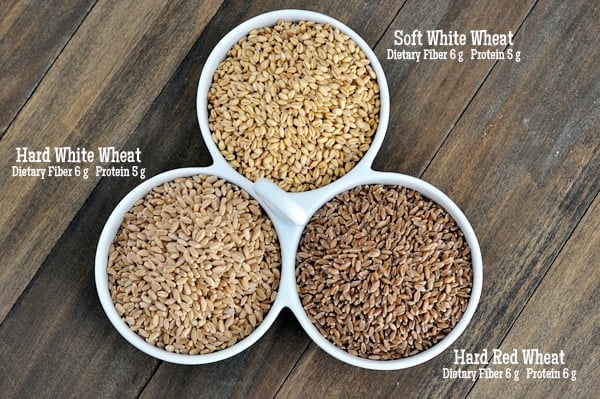 You lot can tell immediately from these pictures that each type of wheat looks a fleck different, both in colour and shape. Notice as well that for every ane/4 loving cup of wheat berries, hard reddish wheat has slightly more than protein while hard white and soft white are the same.
You lot can tell immediately from these pictures that each type of wheat looks a fleck different, both in colour and shape. Notice as well that for every ane/4 loving cup of wheat berries, hard reddish wheat has slightly more than protein while hard white and soft white are the same.
Outset up, allow's take a closer look at soft white wheat. The berries themselves are rounder in shape and they are lighter and more xanthous in color than the other two types of wheat.
Soft white wheat, finely ground, is perfect for tender, light baked goods. Bread, rolls, and even pie crusts, pastries and cookies.
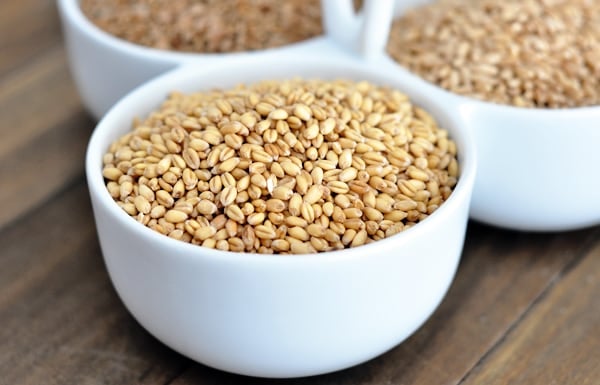
Next, we have hard ruby wheat. Information technology is noticeably darker than the other two white wheat varieties. Because of it'southward slightly higher protein content, it is better used for heartier, heavier breads.
It isn't going to yield the same light color and texture in a baked good that a diverseness of white wheat volition. Many people who try whole wheat breadstuff with red wheat starting time are sometimes disappointed considering it tends to produce heavy, dark loaves.
I always recommend using hard white wheat to commencement; for some reason, information technology seems easier to develop the gluten and get a lighter, more tender bread. I'grand not anti-red wheat (yous'll find out more below); but it is the type of wheat that sometimes gives wheat bread in general a bad rep.
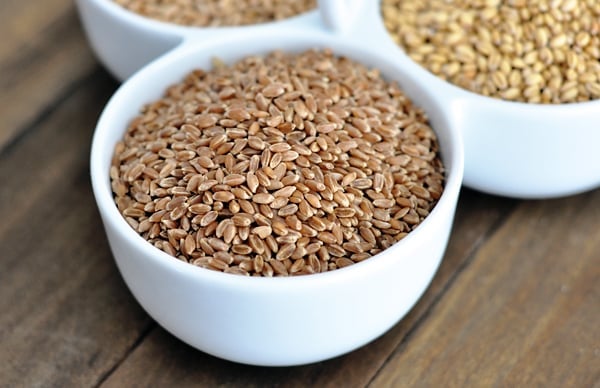
Finally, hard white wheat. Calorie-free colour, just like soft white wheat, but it has a slightly longer, thinner berry shape. This is the type of wheat I use the about.
It is a slap-up all-purpose wheat flour to apply as information technology works bang-up in yeasted breads/rolls and also in cookies and other broiled goods.
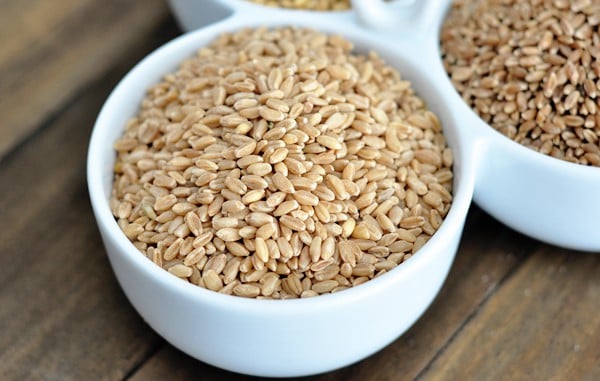
When ground, the wheat berries produce flour at any level of coarseness or fineness, depending on your grain factory or wheat grinder. My rule of thumb, unless I'thousand going for a croaky wheat cereal, is to grind every bit finely equally my grain manufacturing plant allows because I similar to be able to sub the wheat flour in for all-purpose flour and the more finely ground it is, the more hands I can substitute one-for-one with all-purpose flour.
I'll be talking more in-depth well-nigh wheat grinders in a calendar week or so, but a skilful rule of pollex is that one cup of wheat berries produces almost ii cups flour. Proceed in mind, though, that freshly ground wheat flour is total of air from shooting out of the grinder so measuring freshly ground wheat can be a scrap tricky (and is also the reason I utilize approximate amounts of flour for whole wheat staff of life recipes instead of exact measurements). I either permit the flour settle for xxx minutes or and so, or if I'yard going to utilise it right away, I forget my standard flour measuring rule, and pack it in the cup a bit more to account for the airiness of only being ground.
You tin run across from the movie below that the footing wheat flour varies slightly in color, too, depending on the variety of wheat.
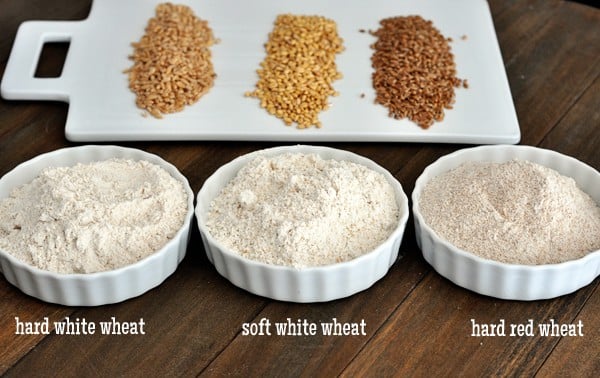
Information technology'south hard to see information technology in this picture below, merely the hard crimson wheat flour (far right) has a chip more texture and a darker colour than the soft white wheat flour to the right.
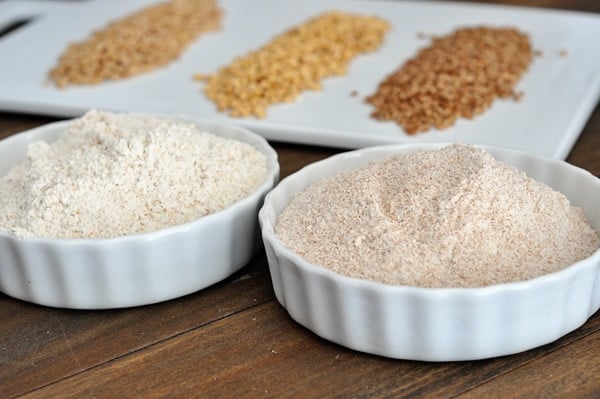
I mentioned above that I prefer using hard white wheat flour. Information technology is definitely what I use xc% of the time; however, I have almost 100 pounds of difficult red wheat hanging out in storage that I bought x years ago that I'thousand trying to use up, and so for the last twelvemonth, I've mixed hard red wheat and hard white wheat (grinding it together) when making breadstuff.
And after shooting pictures for this tutorial, I made bread with all three varieties and what practise you know? I think it was the best bread I've ever made. Then, basically, experiment with the type of wheat you lot prefer – information technology will vary widely amid every person.

When I lived in Northern Minnesota, I bought it from a local, organic manufacturing plant near my home (I know, can you believe I moved to the middle of nowhere with an organic grain mill inside 40 minutes? Awesome). They do provide shipping if y'all are interested in checking out their site, but I have to imagine shipping costs are pretty steep since wheat isn't exactly feather calorie-free.
I've too institute hard white wheat berries at:
- my local Walmart (on the very lesser shelves under the flour)
- Winco (a grocery store in my area in Idaho – they acquit it in 25 pound bags)
- a local farm in Ontario, Oregon (Corn Family Farms – cheque around for any local farms in your area)
There are many, many online sources for wheat, but be aware that shipping costs tin can run high, so information technology might be all-time to cheque your local resource commencement. Here are a few online resources (I am non affiliated with any of these only have bought various products from all of them in the by with nifty results):
Pleasant Hill Grain (probably i of the more reasonable places to buy online)
Emergency Essentials (over again, as I looked at their sales/prices, pleasantly surprised)
Shelf Reliance (more expensive merely has convenient scheduled shipments, if that floats your boat, and their wheat is not-GMO)
Another resource is the LDS (Mormon) Domicile Storage Centers. I'm pretty sure you practise not demand to be a member of the LDS church to can dry appurtenances at the Home Storage Centers (and based on several comments; that's correct!). Hither is a listing of Dwelling Storage Center locations; call for details. Their prices are extremely low, in part because y'all take to/get to pack it and seal it yourself either in cans or mylar bags.
Alternately, if yous don't alive near a Home Storage Center, you can order #ten cans of wheat online at store.lds.org. It runs about $33 for 30 pounds of wheat (they only offer hard white or hard red wheat) and shipping is gratuitous, although you exercise take to live in the continental Usa to order online (cheers for your comments clarifying that!).
Feel gratuitous to share whatever other resources yous've found for buying wheat in the comments!
![]() A quick note on storing wheat berries: every bit with most dry out appurtenances, they should exist stored in a dry, cool place. My sealed cans and buckets are kept in our basement storage (wheat, if stored properly, tin can be kept for upwardly to 20 years or longer!) only I keep a large 50 pound bucket in my kitchen that I fill upwards with the #10 cans or numberless of wheat that I buy or bring upwardly from my personal storage.
A quick note on storing wheat berries: every bit with most dry out appurtenances, they should exist stored in a dry, cool place. My sealed cans and buckets are kept in our basement storage (wheat, if stored properly, tin can be kept for upwardly to 20 years or longer!) only I keep a large 50 pound bucket in my kitchen that I fill upwards with the #10 cans or numberless of wheat that I buy or bring upwardly from my personal storage.
This saucepan is non sealed, significant, it won't keep out bugs or footling easily that like to let the wheat run through their chubby fingers, just I utilize this wheat upwardly quickly and regularly, so as long every bit I go along the hat airtight, I've never had problems with bugs (although those pesky petty hands still find their way in!).
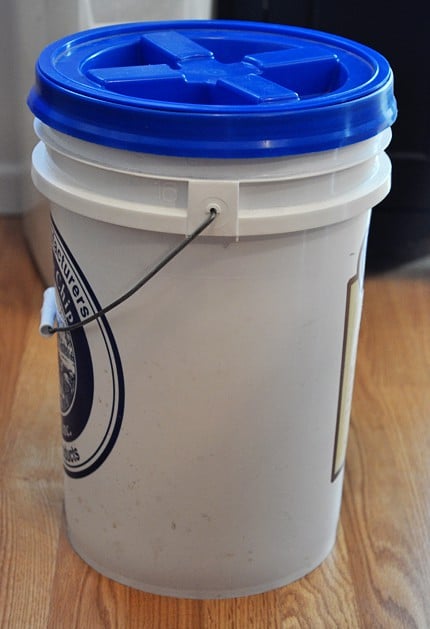
The lid is a keen two-slice plastic ring with a lid that screws on and off. It is brilliant and saves me from prying off the original hat that came with the bucket.
These two-slice lids (sometimes called Gamma Seal Lids), meant to exist used with food-grade fifty# buckets, tin can be found online at any of the wheat resource links above (here is a link from Pleasant Hill Grain).
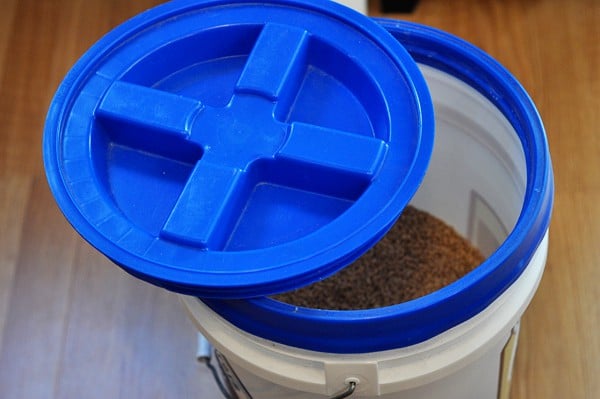
Now on to the skilful stuff.
![]() The obvious reply is clearly to use information technology in breads and rolls (but scroll downwardly for some ideas that are a bit outside of the breadstuff box). I have dozens of yeast recipes on my site and while I haven't specified in each and every one, it'due south a given that any time I make rolls or bread, I use whole wheat flour in place of all-purpose flour.
The obvious reply is clearly to use information technology in breads and rolls (but scroll downwardly for some ideas that are a bit outside of the breadstuff box). I have dozens of yeast recipes on my site and while I haven't specified in each and every one, it'due south a given that any time I make rolls or bread, I use whole wheat flour in place of all-purpose flour.
For staff of life, I always use my trusted 100% whole wheat recipes. For rolls and other breads, I generally use at least half whole wheat flour, sometimes more and sometimes less (with the exception of this ciabatta bread, this rustic crusty bread and a small handful of others which I always splurge and brand 100% white flour).
However, you tin think exterior of the box and apply wheat berries in many other ways besides bread. Here are some practiced ones:
- Homemade Foam of Wheat Cereal: Toast the wheat berries in the oven until lightly gold, let them cool, then grind them in a grain manufactory or wheat grinder to the texture of hot cereal, not fine like flour simply not as coarse equally cracked wheat. You could probably even do that in a blender. Cook or microwave 1 cup of the toasted ground wheat berries in 3 cups h2o for a delicious, hot foam of wheat breakfast (this is honestly one of my boys' favorite breakfast choices with blueberries and a affect of brown sugar and milk).
- Pancake Mix: I apply 100% whole wheat flour for our favorite oatmeal pancake mix. Information technology's hearty, good for you and totally delish.
- Traditional Croaky Wheat: If your wheat grinder can hack information technology, grind the wheat berries for cracked wheat cereal.
- Whole Wheat Blender Pancakes/Waffles: This unique recipe doesn't utilize flour at all; information technology starts with whole wheat berries that are blended with buttermilk and other ingredients. Information technology'south another breakfast staple at our house. You can use whatever type of wheat berry for these.
- Wheat as a Meat Extender: You lot tin can get all wild and crazy and use wheat as a meat extender. It'south amazing! My friend Jenna told me about this years agone after she served me stroganoff that was then tasty, I asked for the recipe and she shyly admitted that the "meat" in the recipe was at least 1/two wheat berries. WHAT? I couldn't fifty-fifty tell. It'due south been years since I've employed this method myself (I need to start again!) but I tin vouch that it works. The wheat takes on the gustation and texture of the meat plus information technology adds a whole lot of actress protein and fiber. Basically you use cooked wheat berrries (cracked wheat) and simmer information technology with your meat (for tacos, stroganoff and other ground beefiness/turkey meals that simmer or cook for a flake). Google "wheat meat extender" and you'll go some good ideas.
Well, I call back that does information technology for today! Next up will be a thorough expect at wheat grinders. Yahoo! (Seriously, stay in your seats, people.)
Please feel gratis to leave any questions in the comments and I'll become to them as shortly as I tin; alternatively, I'd honey whatever suggestions near the discussion today. I accept a feeling I tin can learn a lot from all of your experiences with wheat, too!
Disclaimer: I am a participant in the Amazon Services LLC Associates Program, an chapter advertisement program designed to provide a ways for me to earn fees past linking to Amazon.com and affiliated sites. As an Amazon Associate I earn from qualifying purchases.
How To Cook Red Mill Cream Of Wheat,
Source: https://www.melskitchencafe.com/wheat-and-wheat-grinding-101-the-wheat-types-where-to-buy-and-what-to-make/
Posted by: kadlecyoughat99.blogspot.com


0 Response to "How To Cook Red Mill Cream Of Wheat"
Post a Comment